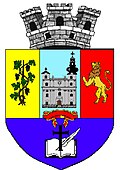Dumbrăveni
|
Dumbrăveni Elisabethstadt Erzsébetváros |
||||
|
||||
| Basic data | ||||
|---|---|---|---|---|
| State : |
|
|||
| Historical region : | Transylvania | |||
| Circle : | Sibiu | |||
| Coordinates : | 46 ° 14 ' N , 24 ° 34' E | |||
| Time zone : | EET ( UTC +2) | |||
| Height : | 345 m | |||
| Area : | 55.75 km² | |||
| Residents : | 7,388 (October 20, 2011) | |||
| Population density : | 133 inhabitants per km² | |||
| Postal code : | 555500 | |||
| Telephone code : | (+40) 02 69 | |||
| License plate : | SB | |||
| Structure and administration (as of 2016) | ||||
| Community type : | city | |||
| Structure : | 2 districts / cadastral communities: Ernea , Șaroș pe Târnave | |||
| Mayor : | Emil Dârloșan ( PSD ) | |||
| Postal address : | Mihai Eminescu Street, no. 6 loc. Dumbrăveni, jud. Sibiu, RO-555500 |
|||
| Website : | ||||
Dumbrăveni [ dumbrəvenʲ ] (outdated Ibașfalău ; German Elisabethstadt or Eppeschdorf , Hungarian Erzsébetváros or Ebesfalva , Latin Elisabethopolis ) is a small town in the Transylvania region in Romania .
Geographical location
Dumbrăveni is located in the northern part of Sibiu County on the Târnava Mare (Great Kokel) , about halfway between Sighișoara (Schäßburg) and Mediaș (Mediasch) .
South of Dumbrăveni, the national road Drum național 14 from Sighişoara (Schäßburg) to Sibiu passes the city. With the completion of the Transylvania A3 motorway , a motorway connection is to be created. The station is also outside in the south of the city and is on the important Teiuş – Braşov railway line , with almost only regional trains stopping in Dumbrăveni.
history
The place was founded in the 13th century by Transylvanian Saxons and first mentioned in 1332. According to archaeological finds on the area of the incorporated town of Șaroş pe Târnave (Sharosh), settlement in the region dates back to the Early Bronze Age .
In the 14th century the settlement became known as Eppeschdorf . In the following times the village was also inhabited by Romanians and Hungarians. In the 15th century the Hungarian noble family Apafi settled there and built a castle in the Renaissance style in 1552 . In 1661 Michael I. Apafi became Prince of Transylvania. Thus the Eppeschdorf at that time became a temporary royal residence.
In the years 1671 to 1685 (under Michael Apafi), the settlement of expelled Armenians from the Vltava was significant for the city's history . As merchants, they received numerous privileges. They eventually acquired the castle and also settled surrounding villages, for example Hoghilag (Halvelagen) , Ernea (Ehrgang) and Scharosch .
In the 18th century Eppeschdorf was renamed Elisabethstadt and received the rank of a privileged city. Gradually, the Armenians adopted the Hungarian language and culture.
The city has belonged to Romania since the end of the First World War. Together with Gherla (Armenian town) , Dumbrăveni is one of the historically significant Armenian towns in Transylvania.
population
In 1850 the city had a total of 2,224 citizens. At that time, 689 citizens identified themselves as being of Armenian origin. In 1930, when the number of inhabitants was almost double, only 32 citizens called themselves Armenians. According to the 2002 census, Dumbrăveni had 8,419 inhabitants, of which 72.9% were Romanians, 13.8% Roma, 11.7% Hungarians and 1.5% Transylvanian Saxons.
Attractions
- The Armenian Catholic Baroque Church Sf. Elisabeta , built between 1766 and 1791, is a listed building.
- The Protestant Church , former Catholic Sf. Ioan Botezătorul , built in 1771 and renovated in 1925, is a listed building.
- The Roman Catholic Church Sf. Apostoli Petru și Pavel , built between 1795 and 1798, is a listed building.
- Apafi Castle, built in 1552, renovated between 1650 and 1700, is a listed building.
- The ARCA Armenian Museum ( Acțiuni de Regenerare a Comunității Armene ) in the Apafi Castle.
politics
The city's local council consists of 15 members. After the 2016 election, seven parties are represented: PSD (6 seats), PNL (5 seats), PMP (2 seats), UDMR and UNPR (1 seat each).
Personalities
Michael I. Apafi (1632–1690), Prince of Transylvania, lived temporarily in Elisabethstadt.
See also
- Armenians in Transylvania
- List of cities in Romania
- List of German and Hungarian names of Romanian places
Web links
Individual evidence
- ↑ 2011 census in Romania at citypopulation.de
- ↑ Harta Interactiva . Homepage of the motorway project Autostrada Transilvania . Retrieved October 11, 2010.
- ↑ Institute Of Archeology - Dumbrăveni from cimec.ro accessed on December 15, 2015 (Romanian)
- ↑ Heinz Heltmann, Gustav Servatius (Ed.): Travel Guide Siebenbürgen. Kraft, Würzburg 1993, ISBN 3-8083-2019-2 .
- ↑ Varga E. Árpád: Szeben megye településeinek etnikai (anyanyelvi / nemzetiségi) adatai. 1850-2002 (PDF; 596 kB). Retrieved October 11, 2010
- ↑ a b c d List of the Romanian Ministry of Culture, updated 2010 (PDF; 7.10 MB)
- ↑ Information on the church at biserici.org accessed on December 15, 2015 (Romanian)
- ↑ Iozefina Postăvaru: The Birth of an Armenian Museum , on August 5, 2010 from araratonline.com accessed on December 15, 2015 (Romanian)
- ↑ Alegeri locale 5th June 2016: Mandate atribiuite pentru Consilieri locali (Romanian) . June 5, 2016. ( MS Excel ; 1.1 MB)






